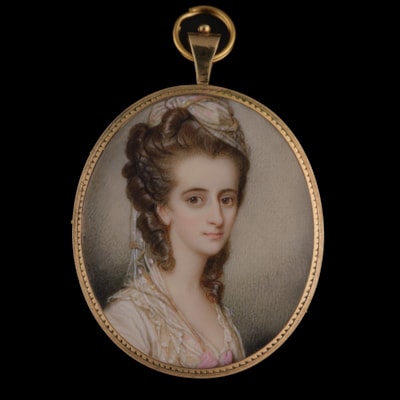CHRISTIAN RICHTER
(1678-1732)Portrait miniature of Sir Edward Bayly, Bt., in an ermine-bordered red cloak, with white lace jabot, and long dark curling hair
6.8 x 0 cm (2 ⁵/₈ x 0 inches)
Watercolour on vellum laid down on card
The backing card reverse inscribed in pen 'Sir Edward Bayly Bart.'
Later silver-gilt frame with scroll hanger.
SOLD
Bayly was a Member of Parliament for Newry, now in Northern Ireland, from 1705. He also owned a large estate in Anglesey. It would be through these two connections that he became a Baronet in 1730, of Plas Newydd and Mount Bagenall[1]. Little else is recorded about the life of Bayly. It is possible that the robes he wears in this portrait relate to his political status, and are Parliamentary robes. These kinds of robes were scarlet, and lines with ermine, and were and still are worn for important parliamentary events such as the State opening of Parliament[2]. Therefore, the miniature could have been created as a commemoration of Bayly’s achievements in the political sphere, when he first entered this at the beginning of the eighteenth century.
Richter had arrived in London in the first decade of the eighteenth century, having learned goldsmithing and metal engraving in his home country, Sweden. He had important connections in London, given that he knew other Anglo-Swedish artists such as Michael Dahl (c.1659-1743) and Hans Hysing (1678-1752/3). His signature stippling technique can be seen in use in this portrait. Many other miniatures done by Richter were copies of his aforementioned peers, making his depiction of Bayly a fine example of the quality of work that he could create from his own sittings, rather than taking from those done by others.
[1] Burke’s Baronetcy, Vol.5, p.351.
[2] ‘Sartorial History of the State Opening of Parliament’, History of Parliament, Online, https://historyofparliament.com/2016/05/18/sartorial-history-of-the-state-opening-of-parliament/

shipping notice
Worldwide shipping is included in all prices.
The Limner Company does not accept any responsibility for import duty, this is to be paid by the buyer.
Some stock items contain materials from endangered species which are governed by CITES regulations and will require a permit to export outside of Great Britain. If a certificate of export is required then this will be the responsibility of and paid for by the buyer .
you may also like













